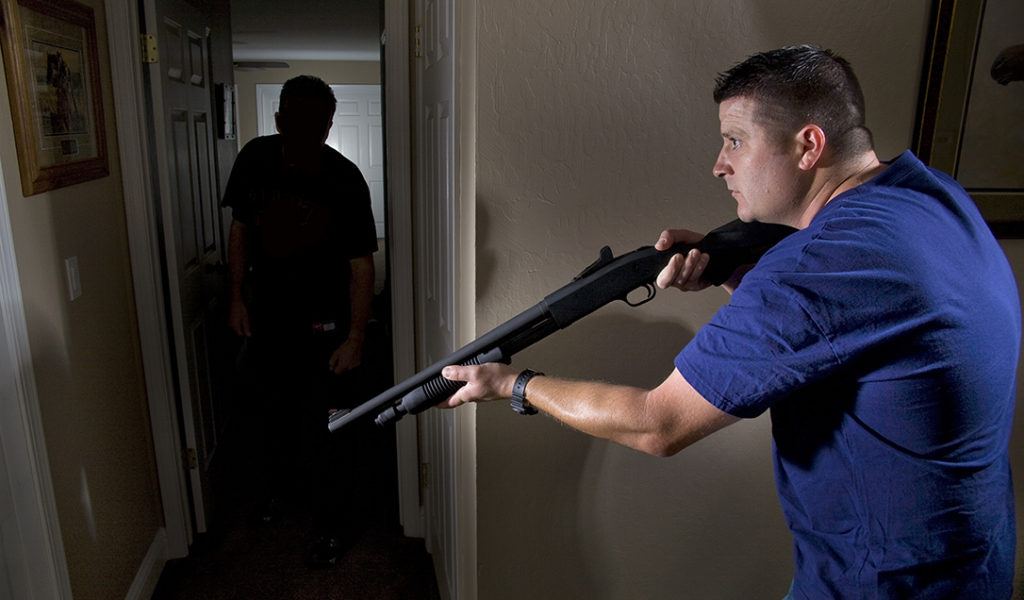No. That’s not how “Castle Doctrine” works in AZ.
It’s one of the most misunderstood areas of self-defense law, often casually referred to as the “Castle Doctrine”. “I’ll shoot anyone who breaks into my home!” or “That door is locked for your protection, not mine.” are some of the favorite phrases used by some ill-educated gun owners to justify their trigger-happy fantasies.
The truth is: The law not what some believe it to be, but it can be broken down very simply.
“The use of deadly force to defend mere personal property in the absence of an imminent threat to a person or persons, is simply unlawful. Period.”[1]
But what about Texas? Well we ain’t in Texas, and Texas law also isn’t as simple as that. Check out this article from CCW Safe written by Andrew Branca, attorney and writer of the book, “The Law of Self Defense”.
Moving on, let’s take a dive into the law in AZ. Let’s start with what many refer to as the “Castle Doctrine”, a term we won’t actually find in law.
“13-419. Presumptions; defense of a residential structure or occupied vehicle; exceptions; definitions
(ARS 13-419, emphasis added)
A. A person is presumed to reasonably believe that the threat or use of physical force or deadly force is immediately necessary for the purposes of sections 13-404 through 13-408, section 13-418 and section 13-421 if the person knows or has reason to believe that the person against whom physical force or deadly force is threatened or used is unlawfully or forcefully entering or has unlawfully or forcefully entered and is present in the person’s residential structure or occupied vehicle.
B. For the purposes of sections 13-404 through 13-408, section 13-418 and section 13-421, a person who is unlawfully or forcefully entering or who has unlawfully or forcefully entered and is present in a residential structure or occupied vehicle is presumed to pose an imminent threat of unlawful deadly harm to any person who is in the residential structure or occupied vehicle.
C. The presumptions in subsections A and B of this section do not apply if:
1. The person against whom physical force or deadly physical force was threatened or used has the right to be in or is a lawful resident of the residential structure or occupied vehicle, including an owner, lessee, invitee or titleholder, and an order of protection or injunction against harassment has not been filed against that person.
2. The person against whom physical force or deadly physical force was threatened or used is the parent or grandparent, or has legal custody or guardianship, of a child or grandchild sought to be removed from the residential structure or occupied vehicle.
3. The person who threatens or uses physical force or deadly physical force is engaged in an unlawful activity or is using the residential structure or occupied vehicle to further an unlawful activity.
4. The person against whom physical force or deadly physical force was threatened or used is a law enforcement officer who enters or attempts to enter a residential structure or occupied vehicle in the performance of official duties.
D. For the purposes of this section:
1. “Residential structure” has the same meaning prescribed in section 13-1501.
2. “Vehicle” means a conveyance of any kind, whether or not motorized, that is designed to transport persons or property.”
This law is not a justification defense; however, it offers self-defenders with some presumptions. Those two presumptions have limitations as listed in paragraph C. In short, this law affords us with the basics:
- That some level of force is needed to defend against unlawful entry during or even after the unlawful entry. This could be physical force or deadly physical force.
- That a person who is or had unlawfully or forcefully entered a residence or occupied vehicle is an immediate deadly threat to the people who are inside.
This presumption is then used to fill in the elements for whichever legal justification is applicable, be it for physical force, or deadly physical force. We dive into the general justifications for using force in self-defense in another blog post, but for now I want to highlight one particular section about this presumption.
“[A] person who is unlawfully or forcefully entering or who has unlawfully or forcefully entered and is present in a residential structure or occupied vehicle is presumed to pose an imminent threat of unlawful deadly harm to any person who is in the residential structure or occupied vehicle.”
ARS 13-419 Paragraph B
ARS 13-418, which is a justification statute, states plainly that the use of force is justified only in response to the imminent threat of death or serious bodily harm:
[A] person is justified in threatening to use or using physical force or deadly physical force against another person if the person reasonably believes himself or another person to be in imminent peril of death or serious physical injury.”
ARS 13-418
This is the take home folks! You are not defending the house, the property, or your stuff. You are defending you or your loved one’s life! The people in the home are being defended when deadly force is in play, not the building itself or the stuff inside. If nobody is inside, then deadly force is not really an option. Legally, morally, and ethically we hold life at a very high value. Reasonable people don’t kill someone over a stolen TV or broken window. Stuff and things are not worth killing over, but if me or my family are in immediate danger of death, I will do what I have to do to defend myself and my family.
PREVIOUS: The Use of Force Continuum > CURRENT: They Value My Stuff Over Their Life > NEXT: Stand Your Ground Law in AZ
*This is provided as a Legal Information Resource and should not be treated as legal advice.
1 . Branca, A. (2019). TEXAS LAW – DEADLY FORCE DEFENSE OF PROPERTY . Retrieved from CCW Safe: https://ccwsafe.com/blog/danger-texas-law-on-deadly-force-defense-of-property

